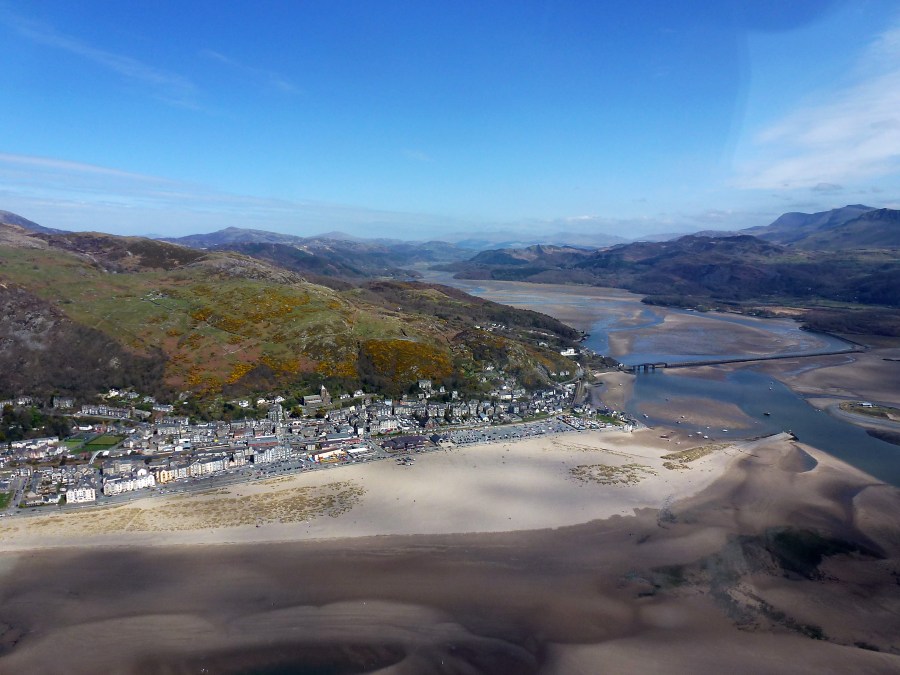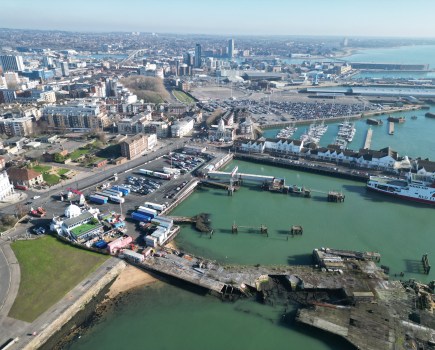PAUL MILES discovers the delightful Welsh coastal town of Barmouth, which is full of surprises.
With an expansive, west-facing beach and dunes, Barmouth has been a popular destination for holidaymakers since Victorian times. There are donkey rides, a fun fair and amusement arcades.
Less well known is the wealth of walks right starting in the town. There are hikes up ‘The Rock’ of Old Town with views of the Mawddach estuary and onwards up the hill of Dinas Oleu. After that exertion, the chip shops, ice cream parlours and doughnut stands might appeal. Otherwise, new cafes selling acai bowls and quesadillas are appearing. Meanwhile new hotels feature upcycled furniture and rain showers. The place feels on the cusp of change.
We arrive by train after a spectacularly scenic journey that hugs the coast and crosses the long wooden railway and pedestrian bridge for which Barmouth is famed. The train station is in the middle of town. It is a short walk to our accommodation, The Tilman, a bar with 11 rooms. The floorboards in the bar are made from old sleepers from the railway bridge. Our room is spacious with interesting furniture and feature lighting. A wet room has a bath and walk-in shower. We have a cuppa and head out for a wander.
We make towards the harbour area, more a sea wall with historic administrative buildings, than a fully enclosed harbour. In the 1700s Barmouth was a busy ship-building port. Ships sailed from here with cargos of woollen fabrics and timber. You can learn more about the town’s nautical past in the Sailors’ Institute reading room, a sweet little corrugated tin building built in the 1890s. It has lovingly polished tables and chairs, historic documents and old photographs, lifeboat plaques and models of boats. The Sailors’ Institute is on a heritage trail (barmouthheritagetrail.org.uk).
The tide is in and the sea laps gently at the harbour wall where children are crabbing. Harbourside cafes are busy with people at outside tables. The Lobster Pot looks good, serving whole local lobster during the season of April to September. We sit with a cold beer and admire the view of the impressive bridge, the estuary and across to Cadair Idris and the mountains of southern Snowdonia.
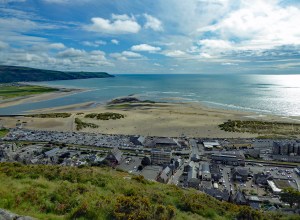
Credit: Barmouth Publicity Association
We have dinner at The Fanny Talbot, a new gastro-pub, owned and run by the same family that owns The Tilman. The pub is named after a woman who donated the first land to the National Trust. She lived in Barmouth at the top of The Rock.
We enjoy bouillabaisse and cassoulet. By the time you read this, if all has gone to plan, the menu will have upped the ante some more with chef Owen Vaughan at the helm. He was a semi-finalist in the latest BBC’s MasterChef the Professionals. Expensive multi-course tasting menus will be the order of the day. There will be accommodation above the pub.
The following morning, after breakfast at the hotel, we head up The Rock, following steps opposite The Tilman that lead between houses. There’s no car access this way, just a maze of steps and alleyways. It reminds me of Ironbridge or Robin Hood’s Bay but on a bigger hill and not as gentrified although some of the homes are cute holiday lets with tiny patio gardens with mountain, sea and estuary views.
At the top, we reach the former home of Fanny Talbot and an arrow pointing to ‘The Mountain’. There’s a fine circular seat, built over 26 years ago to mark the centenary since Fanny Talbot donated her 4½ acres of land, Dinas Oleu, to her friend Octavia Hill, one of the founders of the National Trust. We sit with a flask and admire the 180 degree view that takes in the estuary and mountains to the south east and across to the Llyn Peninsula in the north west, with a foreground of yellow-flowering gorse.
We wander on and find ourselves at a ruined farm, Gellfechan (also Cell-fechan), featuring roofless stone buildings with a magical beauty. The dry stone walls are still sturdy. It feels like stumbling across a secret Inca fortress. The sea sparkles in the distance and crows flap high above.
A family from the Midlands is also there, having a picnic. They’ve travelled to Barmouth for the day to walk over the coastal hills. “We love this place,” says Helen. “In summer the town and beach can be heaving with people but up here there’s no-one.” Our walk continues to a remote holiday home and then returns on a track past ‘Barmouth slabs’ where people are rock climbing.
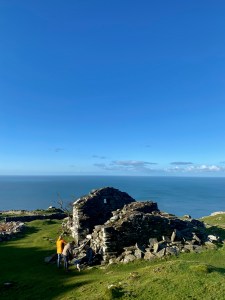
Credit: Paul Miles
The path descends with more estuary views and onwards past Frenchman’s Grave, the final resting place of Auguste Guyard, a poet, herbalist and pacifist who escaped the Franco-Prussian war and lived out his life in Barmouth, gardening on the edge of The Rock. He wrote his own epitaph which is displayed near his grave.
Back in town we wander along the seafront, averting our gaze from car parks, fun fair and ugly housing, by looking out to sea, beyond the wide beach and dunes. There is a population of bottlenose dolphins in Cardigan Bay which can sometimes be seen from shore.
On the prom, Celtic Cabin is a street food vendor that won a BBC Food & Farming award in 2023. We enjoy quesadillas and salads at benches nearby, overlooking the sandy shore where families have set up wind breaks. We find a sheltered place in the dunes and snooze on cool, fine sand among spiky marram grass, the sea all aglitter.
Back at the harbour area, above Davy Jones’ Locker – a café named after sailors’ slang for the seabed – is a small volunteer-run museum recounting the story a ship that was wrecked near here in 1709.
The vessel was carrying a cargo of Carrara marble blocks from Italy, most of which still lie on the seabed. One has been carved into a sculpture that you can find near the Sailors’ Institute. The ship’s bronze bell is the centrepiece of the museum housed in Barmouth’s oldest Tudor building, Ty Gwyn. There are also cannons, cannon balls, combs and plates, all rescued from the wreck by divers. Old black and white photographs of Barmouth show its fishermen, wooden cargo boats and early Victorian holidaymakers.
We have afternoon tea at Goodies in the High Street, owned and run by sisters Melissa and Alice. A massive slab of apricot and yogurt cake accompanied by dinky pots of tea with mis-matched cups and saucers goes down a treat.
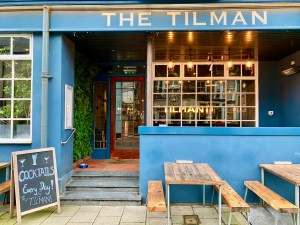
Credit: Paul Miles
After a shower and change at The Tilman, we head to nearby Foxglove, a tiny restaurant with just ten covers run by Antonella Stacchiotti and chef partner Luke Crittenden. The five-course tasting menu is a treat for the tastebuds, each plate an intricate arrangement of flavours, explained to us by Antonella.
Foraged ingredients include reindeer moss, pine cones, unusual sea greens and peculiar mushrooms such as elf caps. Dining here is to experience a succession of beautiful wildflower and fungal forays on a plate.
As well as being a wilderness adventure and artwork, each course is a delicious balance of tastes. We wipe plates clean with warm crusty freshly baked bread. We barely notice that the whole menu is vegan.
Come Sunday morning and it’s raining – ‘liquid sunshine’ as they say in Wales. After a leisurely breakfast we head out to explore some of the independent shops in the High Street. Pieces for Places, in a former Methodist chapel, is full of splendid furnishings and furniture, some of it made in Asia from upcycled wooden fishing boats. Across the road, photographer Dominic Vacher has a new gallery, opened in November 2022. It displays his outstanding scenes of Barmouth and Snowdonia. Dom and his wife moved here from Brighton in 2020. He is successfully turning his photographic hobby into a business.
Other shops of note include Ebeneezer’s Emporium, a haven of kilims, woollen elf slippers and incense. Luvit has rucksacks made from recycled bottles. Walter Lloyd Jones saleroom is a treasure trove of antiques and bric-a-brac. Fudgeridoo is packed to the brim with sweet treats.
Up the hill a little, the massive bulk of the church of St John the Evangelist has the proportions of a cathedral and is worth a wander around on a rainy day. There are even comfy sofas on which to rest. The size of this Victorian church shows how wealthy Barmouth was in the late 1800s, by which time its economy was mostly tourism-related.
Our weekend in Barmouth is nearly over but we have time to burn some calories with a walk across the half-mile-long railway and pedestrian bridge that is nearing the end of a multi-million pound restoration. There’s a £1 toll to pay that helps with the upkeep of this impressive 150-year-old structure. As we walk across, dodging cyclists, a train passes a few feet away. We wave at the driver.
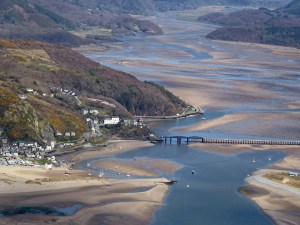
Credit: Barmouth Publicity Association
The views from the bridge of the sandbar on which the coastal village of Fairbourne sits, the sea on three sides, makes the fragility of this seaside village clear. The residents are destined to be the UK’s first climate refugees as the ocean will be allowed to inundate the land. Until then, in summer, there are passenger ferries between Fairbourne and Barmouth harbour, meaning you can take a boat across and walk back over the bridge, perhaps with a ride on Fairbourne’s miniature steam railway first.
We return to the hotel and enjoy a farewell cocktail in the bar before our train home. Rain is now lashing at the windows. We reflect on our weekend. Barmouth has a long history of traditional seaside holidays. Now, thanks to enterprising local individuals with interests in cuisine and design, the bar has raised higher. When the sunshine is liquid, it’s good to know there are cosy places to relax with good food and drink.
Bed and breakfast at The Tilman starts from £120 per night for two sharing.

